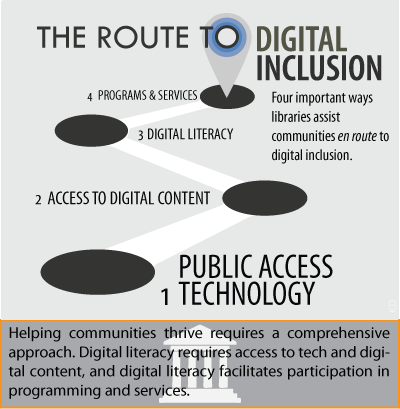
You’ve heard of “digital inclusion,” but what is it, exactly?
The Building Digital Communities Framework for Action offers a concise definition:
Digital inclusion is the ability of individuals and groups to access and use information and communication technologies.
Simply put, digital inclusivity—more formally known as digital inclusion, and sometimes abbreviated “DI”—is about ensuring that the benefits of digital technologies are available to everyone.
This is especially important for two institutions that shape our lives: education systems and workplaces. The COVID-19 pandemic changed how we teach, learn, and work, increasing the urgency of efforts to remove barriers to digital inclusion for every student and worker. Here’s why digital inclusivity is vitally important, both in our schools and workplaces.
What Is Digital Inclusion? A Definition for Educators
Technology plays a major role in how students learn, what they learn, and eventually how they will use it in their adult lives and in the job market. In this new educational landscape, how can we guarantee a fair distribution of opportunities and digital inclusion for all?
Digital inclusion can be broken down into five main areas of focus necessary to ensure that all students—including the most disadvantaged—have access to ICTs.
The five elements of a digitally inclusive educational environment are:
- Affordable and robust broadband internet access
- Internet-enabled devices
- Digital literacy training
- Sufficient technical support
- Applications and accessible online content designed to support learning, literacy, autonomy and participation for all learners
The American Library Association and the University of Maryland carried out a study on digital inclusion, finding that there is a clear pathway for libraries and media providers (and so it follows, schools and educational institutions) on the “Route to Digital Inclusion”:
- Free access to technology tools
- Access to accessible digital content
- Digital literacy services that assist individuals navigate, understand, evaluate, and create digital content using a range of ICTs.
- Programs and services around key need areas

Improving digital inclusivity may seem like a daunting task for busy educators. But they don’t have to do it alone. Governments also play a role in ensuring widespread success.
Digital Inclusivity in Today’s Education System: The Role of Governments
In today’s increasingly blended learning environments, all students should have the ability to access and use all information and communication technology (ICT) tools that are available. What was once an important talking point has now become a critical issue due to the COVID pandemic and the resulting move to hybrid and blended learning.

Governments around the world are seeing the importance of digital inclusion within their communities, and most importantly, within their educational systems.
A decade ago, discussions largely focused on teacher competence, with little interest in digital policy, other than essential connectivity requirements. But with the online education market set to reach $350 billion by 2025, governments are seeing that a digitally-excluded population lacks skills, confidence, and motivation, along with having limited or no access to equipment and connectivity to compete in today’s global environment.
In order for countries to stay competitive, digital inclusion must evolve as technology advances. Governments must have intentional strategies and investments, and strive to reduce and eliminate institutional and structural barriers to technology accessibility.
Digital inclusion has become a major subject of discussion around the world, whether in the U.S. as a part of the emergency COVID relief measures, including $3.2 billion set aside for Emergency Broadband Benefits; in the UK with its guides to using digital technologies to promote inclusivity; or in the EU with its web accessibility and digital inclusion initiatives for a better EU society. At the 2020 G20 summit, digitalization was prioritized in the policy agenda.
How can public and private schools and institutions embrace digital inclusivity?
Importantly, institutions must address digital inclusion from a broad vantage point.
One U.S. government study’s findings suggest that “digital exclusion cannot be predicted or dealt with by categorizing students into groupings of: gender, age, ethnicity, geography, socio-economic status, and educational background. Additionally, the findings indicate that digital exclusion is influenced by organizational factors, such as elements of the course content or navigation of the virtual learning environment rather than intrinsic factors such as individual technological skills.”
This means that access to ICTs and the supporting educational technology tools should be available across the board, throughout the institution. Adoption of performant learning management systems, making content accessible and providing assistive technology tools to all learners are building blocks for a digital inclusion strategy.
Looking to improve digital inclusivity at your educational institution?
Contact us
Today’s learners become tomorrow’s workforce, and digital inclusion can’t stop with graduation. To find out more about the role of digital inclusivity at work, we talked to Michelle Arentz, Learning & Development Consultant and founder of consultancy firm Lazarus Learning. Digital inclusion is an important part of corporate social responsibility, Arentz says—and that’s not all. Here’s a transcript of our 2021 conversation, lightly edited for readability.
Workplace Digital Inclusivity: A Conversation with Michelle Arentz

ReadSpeaker (RS): How do you view digital inclusion in the workplace?
Arentz: Digital inclusion is about ensuring that the benefits of digital technologies are available to everyone. Employees, like students, need to have a healthy digital ecosystem in which to operate and flourish. As we approach the anniversary of a full year of the COVID-19 pandemic, the dust is settling to some degree on the major shift many businesses had to make to accommodate remote working and more. What is being revealed I think is both heartening and troubling.
RS: Interesting. What do you see as the heartening aspects?
Arentz: I think we managed to prove the point that a lot more can be done with technology than we’d previously believed, or wanted to believe. The pandemic was a game changer in allowing more workers than ever to work from home (WFH). Productivity improved in many instances, and greater flexibility in scheduling work—something that was increasingly in demand—became a real thing for many. Work could, was, and is still getting done. There’s even a good possibility that when this is all over, more companies will continue to offer greater flexibility in where work gets done by their employees.

RS: And the troubling part you mentioned?
Arentz: Several things could stand some improvement. For starters, the kinds of jobs that enabled WFH tended to be white collar, higher paying, and more exclusive. Private sector employers outnumbered public employers as having the means to make this move more readily. Race played a role, as that is often tied back to education levels, job categories, income levels, and other factors. Generally, that means if you’re not a college educated professional, chances are you aren’t included in the digital economy that otherwise meant you could stay home and keep safe from COVID.
Even when considering those who can benefit from remote working, we shouldn’t assume they all have equal access to technologies or know how to use them effectively. Just as many students have struggled with the move to learning online and in virtual spaces, so have many workers. Stripping away the context in which we’re used to operating (being in the same room, more easily reading body language, tone, expressions, and such) means one has to work harder to compensate, or get frustrated trying.
RS: There’s definitely been buzz about Zoom fatigue and other imbalances from remote working. Is that what you mean?
Arentz: Yes, that, and more. A digitally-excluded population lacks skills, confidence, and motivation, along with having limited or no access to equipment and connectivity to compete in today’s global environment. Granted, there are some jobs that, no matter what, will never translate into remote working opportunities, like hairdressers or restaurant servers. I can’t help but wonder how many others may have moved themselves more to some level of change, had the technology and training for it been in place. As it is, we’re all disadvantaged when workers are lagging in technological skills and access, whether remote working or not.

RS: What can be done to help close the gap on such disadvantages?
Arentz: In order for companies to stay competitive, digital inclusion for corporate social responsibility must evolve as technology advances. Organizations must have intentional strategies and investments, and strive to reduce and eliminate institutional and structural barriers to technology accessibility. If the educational system is struggling to provide DI, then businesses have to pick up the slack. One cannot assume that everyone in the workforce has the technological skills required to do their jobs, and it cannot be a burden placed on individual workers to figure it out for themselves.
Savvy businesses will stay ahead of the curve by ensuring they have a long-range vision and strategy around digital capabilities, and the ways in which they will keep their employees up-to-date and actively engaged in using them. As well, smart businesses will focus more on inclusivity in general, as having a workforce that is a reflection of the diversity of society at large is also a surefire way to connect with and keep customers.
RS: That’s a good point, that digital inclusion for corporate social responsibility is part of a greater whole of diversity.
Arentz: Absolutely. When the economy picks up and begins to recover (and it will), there will likely be a war for talent. Why leave any options on the table? It’s crystal clear that diversity drives better business results, and the definition of diversity has progressed far beyond the more obvious factors such as gender or race. Making sure everyone has the means to engage in their work further unleashes their potential to create, innovate, and meet challenges head-on.
Bottom line: Digital inclusion for corporate social responsibility is an underserved but powerful part of diversity, one that companies can embrace for standout results to their own bottom lines. Who doesn’t want that?
Read more
How Text-to-Speech Technology Can Help Improve Diversity and Inclusion in Business
Why smart companies choose text to speech over voice actors for their eLearning needs
Interested in finding out how you can incorporate digital inclusion for corporate social responsibility?
Contact us to learn more
About Michelle Arentz

With degrees in Communication Studies and Education, learning has been an integral part of Michelle’s life. Having woven a career tapestry over the past 20+ years that has moved between corporate learning and development and public education, for her, it’s a calling, not just a career. With many years’ experience in content, course, and program design and delivery, making learning engaging and meaningful is her mission. Sharing her love of facilitating and teaching, she has reached a wide range of audiences, from high school students to manufacturing plant workers to corporate leaders, both domestically and abroad. Now operating as an independent consultant and instructional designer in her business, Michelle blends her skills and passion for skill and knowledge advancement in the service of clients who wish to improve the life-long learning journey of themselves and their employees.
About Lazarus Learning

Lazarus Learning LLC was inspired by Michelle’s desire to ‘breathe new life’ into learning content, resurrecting existing materials clients may have, or creating it from scratch. Years of experience in learning and development proved that while many have great knowledge and abilities, it’s not always evident in the materials they have. Everyone benefits when given access to enriched and engaging learning materials and experiences, and Michelle is determined to help rid the world of “death by PowerPoint” as she applies her talents to learning and development.


